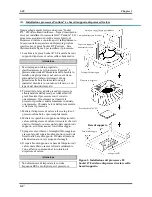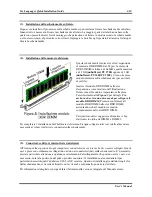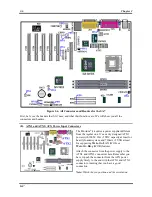
Introduction of SA7 Features
User’s Manual
2-1
Chapter 2. Introduction of SA7 Features
2-1. Features of SA7 Motherboard
This motherboard is designed for use with Intel’s latest generation of Pentium
®
4 478 pins processors.
Based on the new SiS 645DX chipsets (SiS 645DX & SiS 961B), this motherboard supports 400 MHz /
533 MHz system bus (100 MHz / 133 MHz Quad Data Rate) and SiS MuTIOL
®
(Multi-threaded I/O Link)
Technology connecting with SiS 961B MuTIOL
®
Media IO. The Intel
®
Pentium
®
4 processors feature the
new NetBurst Micro-architecture, which enriches the user experience in Net surfing and Multimedia
activities.
The AGP interface can support an external AGP slot with AGP 1X/2X/4X capability and Fast Writes. A
high bandwidth and mature SiS MuTIOL
®
technology is incorporated to connect the SiS 645DX and SiS
961B MuTIOL
®
Media I/O together. SiS MuTIOL
®
technology is developed into three layers. The
Multi-threaded I/O Link Layer delivers 1.2 GB of bandwidth to connect embedded DMA Master devices
and external PCI masters to interface with the Multi-threaded I/O Link layer, the Multi-threaded I/O Link
Encoder/Decoder in the SiS 961B to transfer data with 533 MB/Sec of bandwidth to/from Multi-threaded
I/O Link layer to/from SiS 645DX, and the Multi-threaded I/O Link Encoder/Decoder in SiS 645DX to
transfer data with 533 MB/Sec to/from the memory sub-system to/from the Multi-threaded I/O Link
Encoder/Decoder in SiS 961B.
The SiS 645DX chipset used in this motherboard supports three DDR DIMMs for a maximum of up to 3
GB. The memory controller can support both DDR (up to DDR PC 2700, it running on 166 MHz and
triggered by rising and falling edge) and SDR. It can offer bandwidth up to 2.7 GB/Sec under DDR 333
and 1 GB/Sec under PC 133 in order to sustain the bandwidth demand from the host processor, as well as
the multi I/O masters and AGP masters. DDR SDRAM is the newest memory standard, and it provides
maximum translation bandwidth and also greatly improves data transaction delays. This feature improves
whole system performance and speed, especially in multimedia environment applications.
The SA7 has a built in Ultra DMA 133 function. This means that it provides speedier HDD throughput
boosting overall system performance. Ultra DMA 133 is the new standard for IDE devices. It enhances
existing Ultra DMA 33 technology by increasing both performance and data integrity. This new
high-speed interface almost doubles the Ultra DMA 66 burst data transfer rate to 133 Mbytes/sec. The
result is maximum disc performance using the current PCI local bus environment. Another benefit is you
can connect four IDE devices in your system through either Ultra DMA 66 or Ultra DMA 100 and Ultra
DMA 133. You will have more flexibility to expand your computer system.
The AC’ 97 Audio codec is compliant with the AC’ 97 2.2 specification, and supports 18-bit ADC
(Analog Digital Converter) and DAC (Digital Analog Converter) resolution as well as 18-bit stereo
full-duplex codec with independent and variable sampling rates. Further features include support for four
analog line-level stereo inputs.
This motherboard also supports five PCI slots and one AGP slot. In addition, this motherboard gives users
enormous flexibility through ABIT’s SoftMenu
™
technology. With multiple clock frequency selections,
the user is able to alter both the FSB speed and the multiplier to determine the CPU processing speed
without cumbersome jumpers. This motherboard has built-in hardware monitoring functions that monitors
and protects your computer, ensuring a safe computing environment.
















































